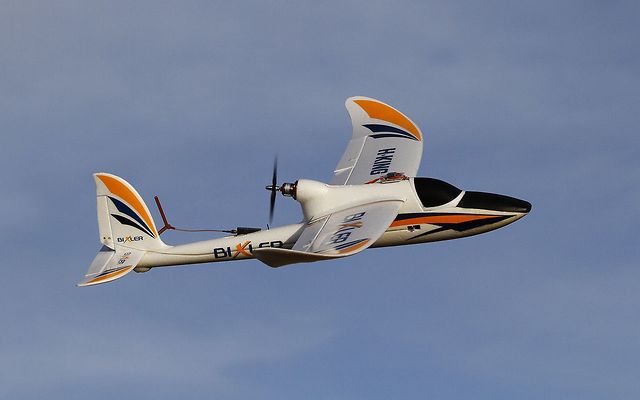A drone based on the Raspberry Pi. Part 1
Hi,% Habrayuser%. I want to share a story about my drone (UAV) on the Malinka.
Before you start making the drone, there was a choice of which flying model to take as a basis: a quadcopter or a plane? Since I played enough with copters, I know their main disadvantage: most often the flight time is 10-20 minutes. For me personally, this is very small, so it was decided to base the aircraft.

I chose Bixler 2 as an airplane, there are a lot of advantages in it, namely:
')

Now it remains the case for autopilot. The Raspberry PI B + with the NAVIO board, on which the sensors we need are located, is taken as the “brains”:
Perhaps many have heard, and someone managed to test the ArduPlane. This is an open source autopilot project for copter / aircraft / rover. Fortunately, the EMLID team, which developed the NAVIO board, made the ArduPlane port on the Raspberry PI. So all that is needed is to clone the repository and compile the whole thing on a raspberry, then fix our autopilot on the plane - and go.
Mount our autopilot to the aircraft:

Then I ran into problems: there was very little space, I had to abandon the standard pilot cockpit that came with the plane, and make a new cockpit out of an empty box for Coca-Cola, painting it in silver. It turned out that it looks much better than the standard one.
Frankly, it did not work out the first time. Since I could only launch the plane on weekends and the weather did not always smile, then from the moment I had the plane ready and until the first successful launch, one and a half months passed.
I flew in stabilization mode: if you do not move the levers on the control panel, the plane aligns itself and flies in a straight line. The next stage will be a flight through GPS points with a pre-planned route.
Now, perhaps, someone will be interested in the price of the issue. So:
In total, I got $ 334 for the whole set, ready to fly. Someone will say that it is expensive and may be right. However, I believe that this is a gift, despite the fact that I have a flying Linux, to which I can connect a 3G modem and change the flight path wherever there is Internet coverage.
Of course, I attach the video of a successful flight:
In the next article, I’ll show you how to set up Xbee connection to Ardupilot on Navio \ Raspberry Pi to transfer telemetry to a laptop with APM Planer installed.
Before you start making the drone, there was a choice of which flying model to take as a basis: a quadcopter or a plane? Since I played enough with copters, I know their main disadvantage: most often the flight time is 10-20 minutes. For me personally, this is very small, so it was decided to base the aircraft.

I chose Bixler 2 as an airplane, there are a lot of advantages in it, namely:
- Price
- Indestructibility
- Wingspan (1.5m)
')

Now it remains the case for autopilot. The Raspberry PI B + with the NAVIO board, on which the sensors we need are located, is taken as the “brains”:
- GPS \ GNSS
- accelerometer, gyroscope, magnetometer
- pressure sensor for height calculation
- 4-channel ADC
- 16-channel PWM generator
- FRAM, non-volatile memory
- RGB LED
- PPM login
Perhaps many have heard, and someone managed to test the ArduPlane. This is an open source autopilot project for copter / aircraft / rover. Fortunately, the EMLID team, which developed the NAVIO board, made the ArduPlane port on the Raspberry PI. So all that is needed is to clone the repository and compile the whole thing on a raspberry, then fix our autopilot on the plane - and go.
Mount our autopilot to the aircraft:

Then I ran into problems: there was very little space, I had to abandon the standard pilot cockpit that came with the plane, and make a new cockpit out of an empty box for Coca-Cola, painting it in silver. It turned out that it looks much better than the standard one.
Frankly, it did not work out the first time. Since I could only launch the plane on weekends and the weather did not always smile, then from the moment I had the plane ready and until the first successful launch, one and a half months passed.
I flew in stabilization mode: if you do not move the levers on the control panel, the plane aligns itself and flies in a straight line. The next stage will be a flight through GPS points with a pre-planned route.
Now, perhaps, someone will be interested in the price of the issue. So:
- Bixler 2 - $ 90 (no remote, I had one)
- 2600mAh Battery - $ 50
- Raspberry Pi B + (sd card) - $ 45
- NAVIO - $ 149
In total, I got $ 334 for the whole set, ready to fly. Someone will say that it is expensive and may be right. However, I believe that this is a gift, despite the fact that I have a flying Linux, to which I can connect a 3G modem and change the flight path wherever there is Internet coverage.
Of course, I attach the video of a successful flight:
In the next article, I’ll show you how to set up Xbee connection to Ardupilot on Navio \ Raspberry Pi to transfer telemetry to a laptop with APM Planer installed.
Source: https://habr.com/ru/post/247665/
All Articles